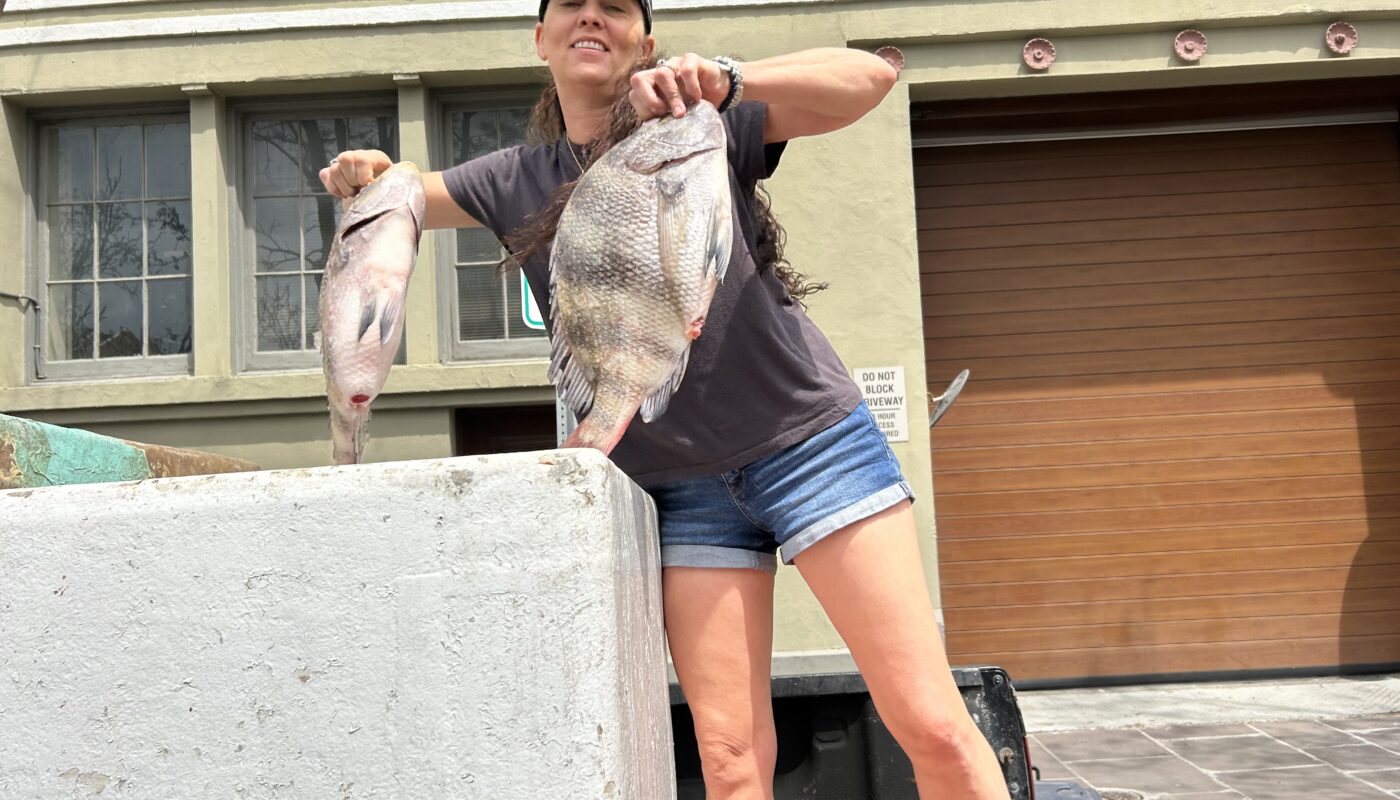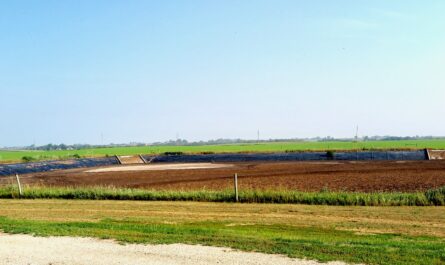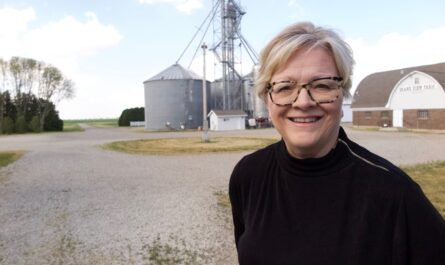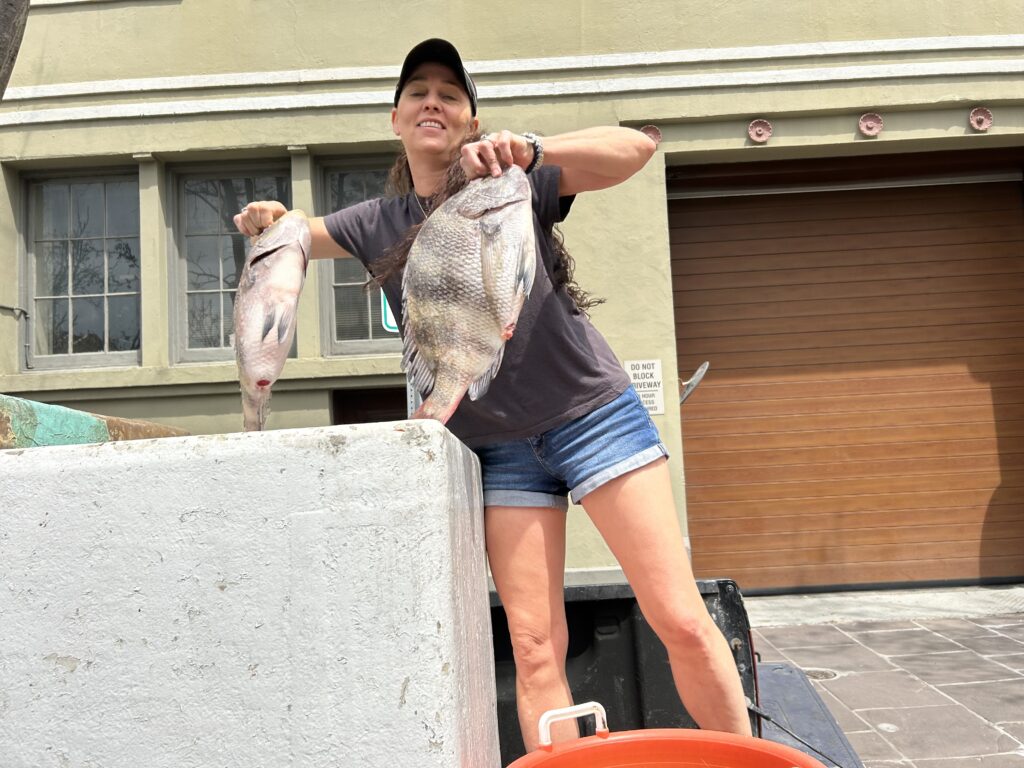
VENICE, LA. — Kindra Arnesen is a 46-year-old Louisiana fishing boat operator who spent most of her life among the pelicans and bayous 20 miles upstream from where the Mississippi River ends at the Pass A Loutre State Wildlife Management Area on the Gulf of Mexico.
Clark Porter is a 62-year-old farmer who lives close to Reinbeck, Iowa where he spends one part of his day as an environmental specialist for the Iowa Department of Agriculture and Land Stewardship, and the other part raising corn and soybeans on 570 acres, most of it owned by his family for over a century.
Though they’ve never met, and live 1,100 miles apart, Arnesen and Porter are tied to a deepening water pollution and public health emergency that has emerged at the center of the country. Near Arnesen’s home lies an expansive oxygen-depleted marine death zone in the northern Gulf caused by dying toxic algae that absorb oxygen and suffocate shrimp and fish.
Porter’s farm lies close to the center of the Upper Mississippi River Basin where tens of thousands of drinking water wells and thousands of miles of streams and rivers are heavily contaminated and cancer incidence is among the nation’s highest and rising.
The culprit at the center of it all is a colossal tide of fertilizer and animal manure that that drains into the Mississippi River from Iowa and other big farm states where more fertilizer is applied and more manure is spread than in almost any other agricultural region in the world. The same agricultural pollution problems are plaguing other iconic US waterways, including Chesapeake Bay, Lake Erie, Lake Okeechobee, and Lake Champlain.

For nearly 30 years the U.S. Environmental Protection Agency has led a federal, tribal, and 12-state task force dedicated to shrinking the Gulf death zone by impeding fertilizer and manure from running off cropland at the center of the country. The favored government solution is a suite of voluntary eco-sensitive conservation practices that farm sector leaders insist will reduce the monstrous pollution. They include: idling land, not plowing before planting, raising cover crops after fall harvest, building retention ponds and wetlands to collect and absorb nitrogen, and planting nitrogen-absorbing vegetation in buffer strips along streams.
Yet despite a torrent of federal and state investment to pay for the practices – over $30 billion has been spent on conservation programs in the Mississippi Basin since the project’s start in 1997 – all that spending has yielded scant progress.
The U.S. Geological Survey reports that nearly 4 billion pounds of nitrogen continues to pour every year into the Mississippi River, which drains 40% of the nation. In their most recent assessments, farm states report that nitrogen pollution is increasing in the upper Basin, the primary source of the pollutant.
From 2010 to 2022 the average annual amount of nitrogen leaving farmland in Iowa was 666 million pounds. That was 14 percent more nitrogen than from 1980-1996, according to state data.
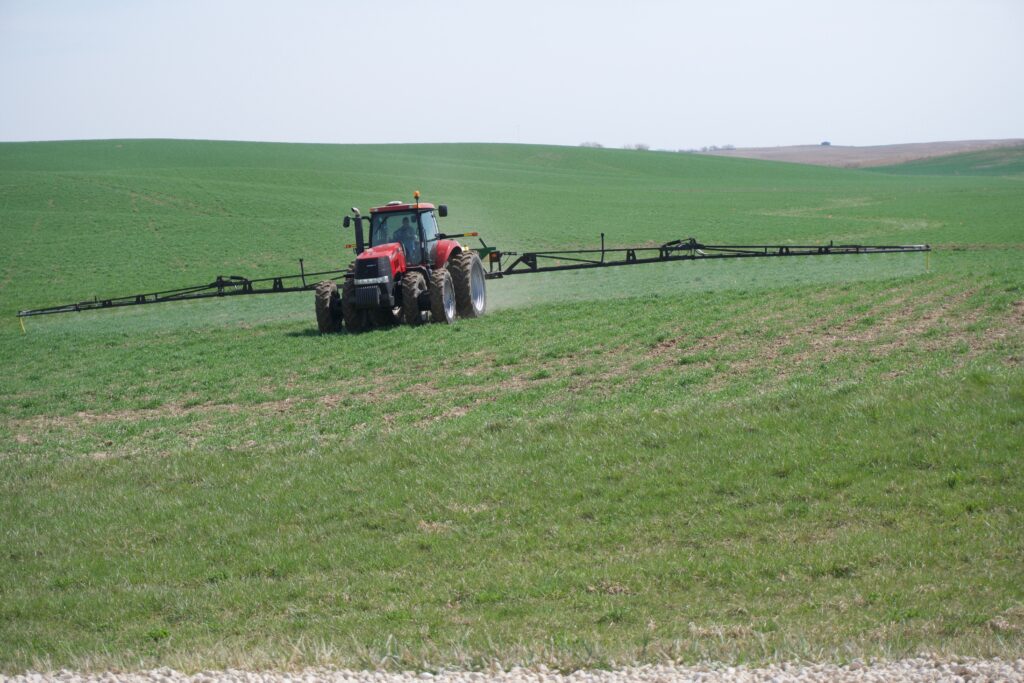
In Minnesota, state authorities found nitrogen in major rivers, including the Mississippi increased from 21 percent to 55 percent over the past 20 years, according to a summary report in 2020.
The two glimmers of change are that government studies measuring nitrogen concentrations in the river flow downstream assert they have declined 3.2 percent in recent years. And the oxygen-depleted Gulf “hypoxic” zone measured over 3,000 square miles last summer, which is smaller than in previous years. But that was due, say scientists, to higher water temperatures caused by climate change and the deep drought in the Midwest that reduced the river’s flow into the Gulf. Two years before, following a typically wet spring and summer, the hypoxic zone was twice as large.
Ineffective Campaign
In every way, the government’s Mississippi Basin campaign to curb nutrient wastes and shrink the Gulf dead zone serves as a proxy for the frustrating, inordinately expensive, grudging effort to control agricultural nutrient wastes, the primary source of what the E.P.A calls “the single greatest challenge to our nation’s water quality.” Just as with similar government-led and equally futile campaigns to curb farm nutrient pollution in other iconic American waters, state and federal agencies are charging ahead with what can only be described as the costliest and least effective pollution prevention strategy ever devised.
“The thing is the E.P.A., the U.S.D.A. What they like to do is tell you they are spending all this money, therefore they must be doing something right,” said Silvia Secchi, a professor and natural resource economist at the University of Iowa. “But if you look at water quality data, at what’s really happening, it’s getting worse, not better.”
“More nitrogen is coming off the fields,” added R. Eugene Turner, professor of oceanography and coastal sciences at Louisiana State University and an expert on the Gulf hypoxic zone. “On average the load and the concentrations of nitrogen in the river are not coming down.”
The E.P.A. did not agree to requests for an interview for this article. The U.S.D.A., in an email message, said that In separate reports in 2017 and 2022 agency researchers “documented some promising trends nationally for reducing nutrient losses, such as increases in cover crop use, increased use of advanced technologies such as use of enhanced efficiency fertilizers and use of variable rate fertilizer application technologies, and a slight increase in soil testing. However, the key finding was that there was a national decline in nutrient management over a decade resulting in an increased loss of subsurface nitrogen and soluble phosphorus loss.”
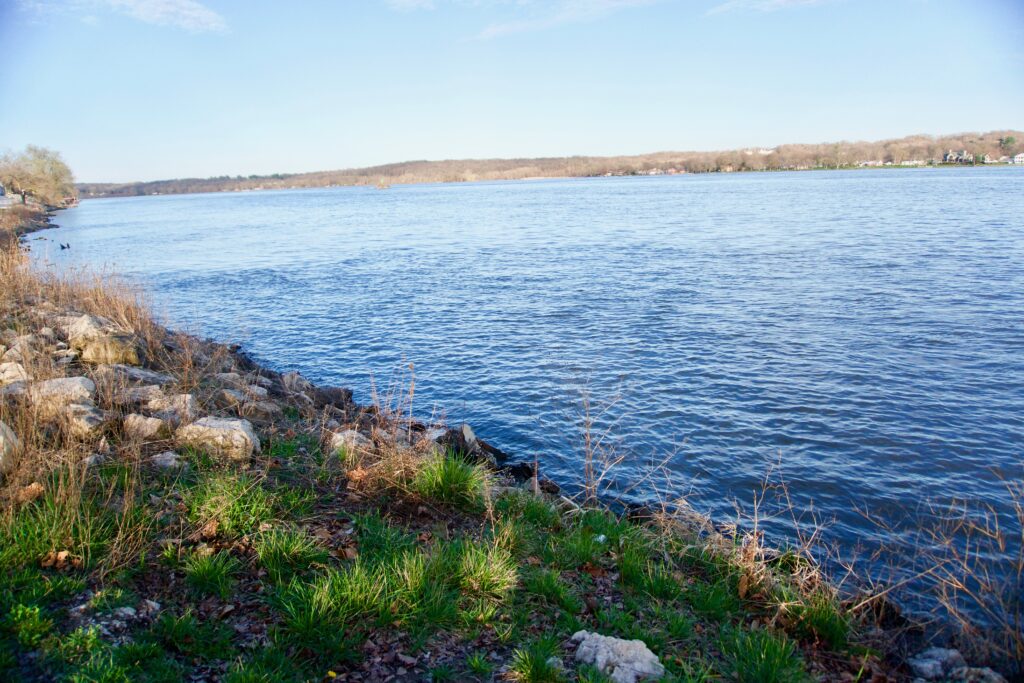
flows downstream annually from Upper Basin states. (Photo/Keith Schneider)
On Individual Farms Some Progress
There’s a reason federal and state agencies count so heavily on conservation practices to cure nutrient pollution. In field trials conducted by agricultural universities, and where farmers apply them over a period of years, they really work. Cover crops planted after harvest have been found to reduce nutrient runoff up to 70 percent. Planting vegetation in drainage ditches, installing sediment retention ponds, and building wetlands can lower nitrogen pollution by 50 percent.
Porter’s farm is an example. Starting in 2011 he replaced the conventional high-chemical, excess fertilizer, plow-every-acre cultivation methods he’d used for years with pollution-reducing “best management practices” paid for by the state and federal governments. He plants cover crops on 550 acres in the fall to reduce erosion, build soil health, and keep excess nitrogen fertilizer in the ground. He constructed buffer zones in low-lying areas to prevent nitrogen from draining into streams. He retired 13 acres and raised a fertilizer-free meadow. The cost has been paid by state and federal grants.
As his diligence and techniques took hold over a decade, the farm’s soil fertility improved and the amount of fertilizer he spread diminished, as did the level of toxic nutrients leaving his land. Samples of water draining from his farm showed nitrogen concentrations of 1 to 2 parts per million or less, equivalent to natural background levels.
“It’s a little like a jigsaw puzzle,” said Porter. “It’s a systemic solution with multiple layers of best management practices that you fit together based on your topography, your soil types. It’s all available. It can work.
Not Sufficient Participation
But here’s the rub. On the scale needed, across the millions of acres in big farm states, conservation practices are not working. That’s because not nearly enough Corn Belt crop and livestock producers use them.
Two of the largest conservation programs, for example, are the Conservation Stewardship Program (CSP) and the Environmental Quality Incentives Program (EQIP), both administered by the U.S. Department of Agriculture. Last year, according to an analysis by Michael Happ, a researcher at the Minneapolis-based Institute of Agriculture and Trade Policy, the USDA spent $400 million in CSP and EQIP payments in the six biggest Mississippi River Basin farm states – Illinois, Indiana, Iowa, Minnesota, Missouri, and Wisconsin. It’s a portion of the roughly $2 billion that the federal and state governments annually spend on conservation programs in the Mississippi Basin.
But farmers in those six states – the basin’s largest source of nitrogen – apply CSP and EQIP practices to fewer than 3 million acres, according to federal data. That’s less than 3 percent of the 119 million acres of cropland in those states.
Sociologists who study why producers aren’t flocking to be paid to improve soil, conserve water, reduce runoff, and lower expenses, say the biggest impediments are the substantial changes required in how they farm. And their fear of losing productivity and revenue.
As a specialist with the Iowa Department of Agriculture who counsels farmers on best management practices, Porter explains it this way: “It’s perceived risk. Fear and worry about the effects on their drainage and their bottom line, and on yields. It’s a different system of farming than the one they’re using.
This is where Arnesen fits in. The heavy pulse of nitrogen carried downstream by the Mississippi River feeds great blooms of algae in the Gulf of Mexico near her watery domain and close to the river’s mouth. When the algae die, decomposition absorbs available oxygen, suffocating shrimp and fish.
“I started fishing offshore in the Northern Gulf of Mexico 25 years ago,” she said in an interview. “We caught everything. Not like it is now. In the grand scheme of things, with the dead zone, I do believe that there’s got to be a tipping point where the concentration is going to get bad enough that we’re going to see mass die-offs.
Though they come from opposite ends of the mighty Mississippi, Arnesen and Porter are describing the limits of a big U.S. pollution prevention program that not only has stopped evolving, but is now making contamination and its consequences worse.
Among the reasons, one stands out. Agriculture took advantage of the limited reach of the principal U.S. water protection law.
Limits of The Law
Ever since the federal Clean Water Act was enacted in 1972, the U.S. strategy for clearing pollutants from the nation’s waters has been split in two. The law provided the E.P.A. and states powerful authority to limit chemicals and contaminants from industrial plants, wastewater treatment facilities, and other “point” sources of pollution. Congress provided ample funds to modernize water treatment systems. Streams, lakes, and rivers got much cleaner.
But that progress has not only stopped, it’s going in reverse. The same 1972 water law provided little authority for federal and state governments to regulate what it called “nonpoint” sources of contamination, a technical term specifically directed at agriculture. Nonpoint is, essentially, a euphemism for allowing crop and livestock operations to spread, spray, and discharge farm chemicals and manure into the environment without restraint.
At the time in the early 1970s, the implications of waiving oversight of nonpoint farm pollution was not thoroughly evaluated. U.S. agriculture largely consisted of smaller, lower-polluting, mixed crop and livestock farms that grazed animals in manure-absorbing pastures.
But putting farms out of the Clean Water Act’s reach has since proved to be a significant factor in the conversion of agriculture to mammoth corn farms, which use more fertilizer than any other crop, and thousands of industrialized manure-saturated livestock operations. The regulatory waiver enabled farm producers to avoid the cost of responsibly managing the largest waste stream of any industrial sector in U.S. history.
Had the farm sector been held accountable for its wastes, as is required for every other industry, it would have been compelled to keep fertilizer and manure out of surface and groundwater. That, in turn, would have kept farms operating at a scale that brought environmental costs in line with revenue.
The result is a mismatch. The torrent of nutrients pouring off cropland has overwhelmed state and federal government efforts to control them. “The scale of the problem dwarfs the level of response, unless you change the design of the dominant crop and livestock production systems,” said Matt Liebman, professor emeritus of agronomy and sustainable agriculture at Iowa State University.

The Mississippi River Basin campaign is a case in point.
Dead Zone In The Gulf
When it was first identified in the 1950s, what scientists now call the Northern Gulf Hypoxia Zone was seen as a small biological curiosity. As science advanced, researchers gained greater understanding of the peril to marine life, particularly shrimp. In 1985, with federal support, a team of state and federal researchers led by Nancy Rabalais, a marine ecologist at Louisiana State University, began mapping the toxic zone, which was growing larger from pollution coming from upstream.
“The Mississippi River watershed and the ocean are together,” she said in an interview in Baton Rouge. “This is a large ecosystem, the land and the sea. Each affects the other. Most of the precipitation that falls in the Midwest actually comes from the water cycle in the Gulf of Mexico.”
In 1998, Congress passed the Harmful Algal Bloom and Hypoxia Research and Control Act to solve pollution in U.S. coastal waters. With federal funds assured, the EPA formed the task force to achieve three primary strategic objectives.
First, the federal government invested hundreds of millions of dollars in science – much of it in grants to public universities – to pinpoint sources of nutrient contamination and their environmental consequences.
Second, tens of millions of dollars more has been invested in meetings, conferences, zoom calls, and field exercises to establish the peer-to-peer, state-to-state, state-to-federal collaboration that the big regional project requires. A sizable multi-state community of scientists, agency personnel, academics, and nonprofit staff members has developed over the last three decades to communicate and share knowledge.
But the Mississippi Basin task force, just like the other big nutrient pollution prevention campaigns in the Great Lakes, Chesapeake Bay, Florida, and Vermont, has not even come close to gaining a firm grip on the third objective – actually reducing the pollution.
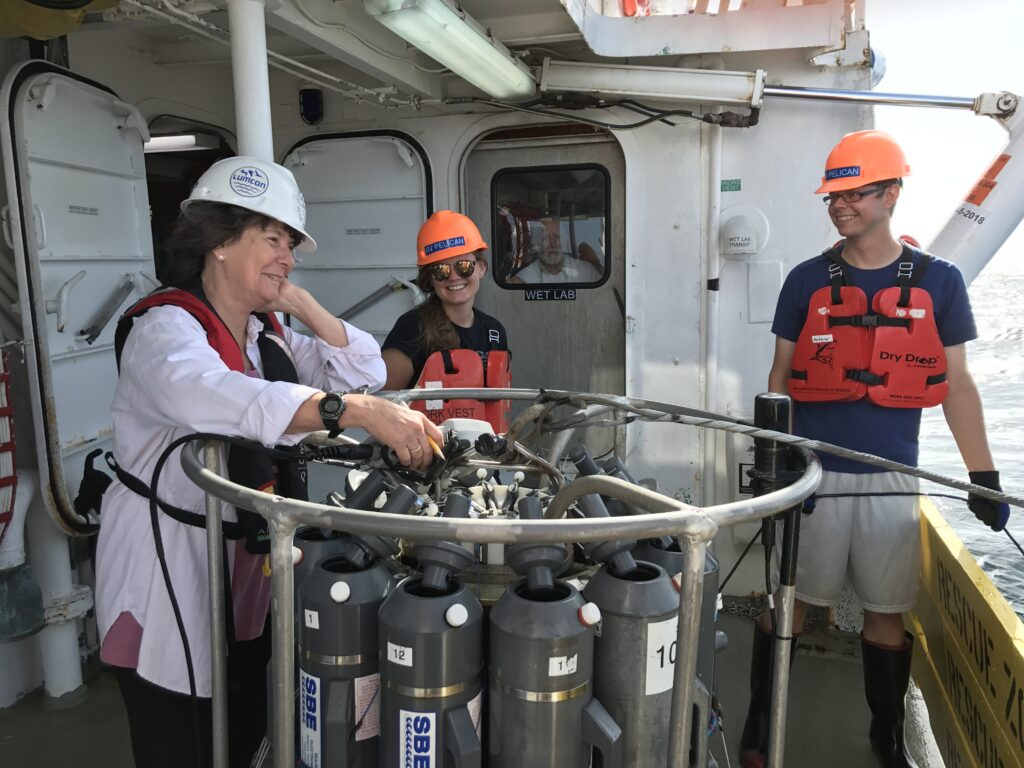
to measure the Gulf hypoxia zone starting in 1985. (Photo courtsey of Dr. Rabalais)
The Mississippi task force certainly tried. One action step was straightforward. Upgrading wastewater treatment facilities – a “point source” under the law – to scrub nitrogen from discharges to the river. Congress authorized nearly $10 billion over the last two decades to distribute to states and communities to modernize sewage plants. As a percentage of nitrogen flowing into the Mississippi, treatment plant discharges now make up less than 5 percent, according to federal data.
But even as wastewater plants modernized, the Gulf hypoxic zone increased in area, reaching more than 8,000 square miles in 2002 and again in 2008. Frustrated E.P.A. officials threatened to take more decisive action by using the agency’s authority under the Clean Water law to set a formal limit for nitrogen in fresh water, just like it does for other harmful chemical pollutants. That action would require states to do what is necessary to comply.The warning stirred Iowa, Minnesota, Illinois, and the other basin states to prepare “nutrient reduction strategies” that promised to deal with the problem. Iowa and Minnesota approved new sales tax-supported funds to improve water quality, though Iowa legislators never approved the tax to support the program. In every state, the favored solution was the same as the federal government’s: pay farmers to voluntarily apply those conservation practices to their operations.
The warning stirred Iowa, Minnesota, Illinois, and the other basin states to prepare “nutrient reduction strategies” that promised to deal with the problem. Iowa and Minnesota approved new sales tax-supported funds to improve water quality, though Iowa legislators never approved the tax to support the program. In every state, the favored solution was the same as the federal government’s: pay farmers to voluntarily apply those conservation practices to their operations.
It hasn’t worked for reasons aside from low participation by farmers. Congress, pushed by the farm sector, is funding programs and policies that work at cross-purposes with the task force’s objective.
First is the drainage systems on cropland in the big Upper Basin farm states. A lattice of perforated pipes, called tiles, has been installed beneath the surface of most land planted in corn. Tiles behave like vacuum cleaners, sucking up excess water and nitrogen not absorbed by growing plants. The tile network, which expands every year, discharges the p0lluted water into ditches and streams that eventually empty into the Mississippi.
The second reason is that Congress spends tens of billions of dollars annually to incentivize more acres planted in corn and larger livestock and poultry operations, most of it focused on Mississippi River Basin states. Much more commercial fertilizer and manure is being spread on cropland.
American livestock and poultry operations generate 1.4 billion tons of nitrogen-rich manure annually, most of it in the Upper Basin states. State and federal data also show that since 1990, nitrogen spread in U.S. corn-growing states has increased 26%. As much as 70% of nitrogen spread on farms is not absorbed by growing crops.
In 1980, when industrialization really started to take hold in American agriculture, nitrogen discharged annually to the Mississippi River totaled 1.4 billion pounds, according to the E.P.A. It’s nearly three times that amount now, according to the U.S. Geological Survey.
The titanic tide of nutrients has forced the E.P.A. and its task force collaborators to adjust their goals for the Gulf hypoxic zone. In 2008, the group said it wanted to shrink the area to a five-year average of 1,930 square miles by 2015. In 2015, it said that same goal would be achieved by 2035. It’s not at all clear, under current law, whether the task force’s aspirational goal can ever be achieved.
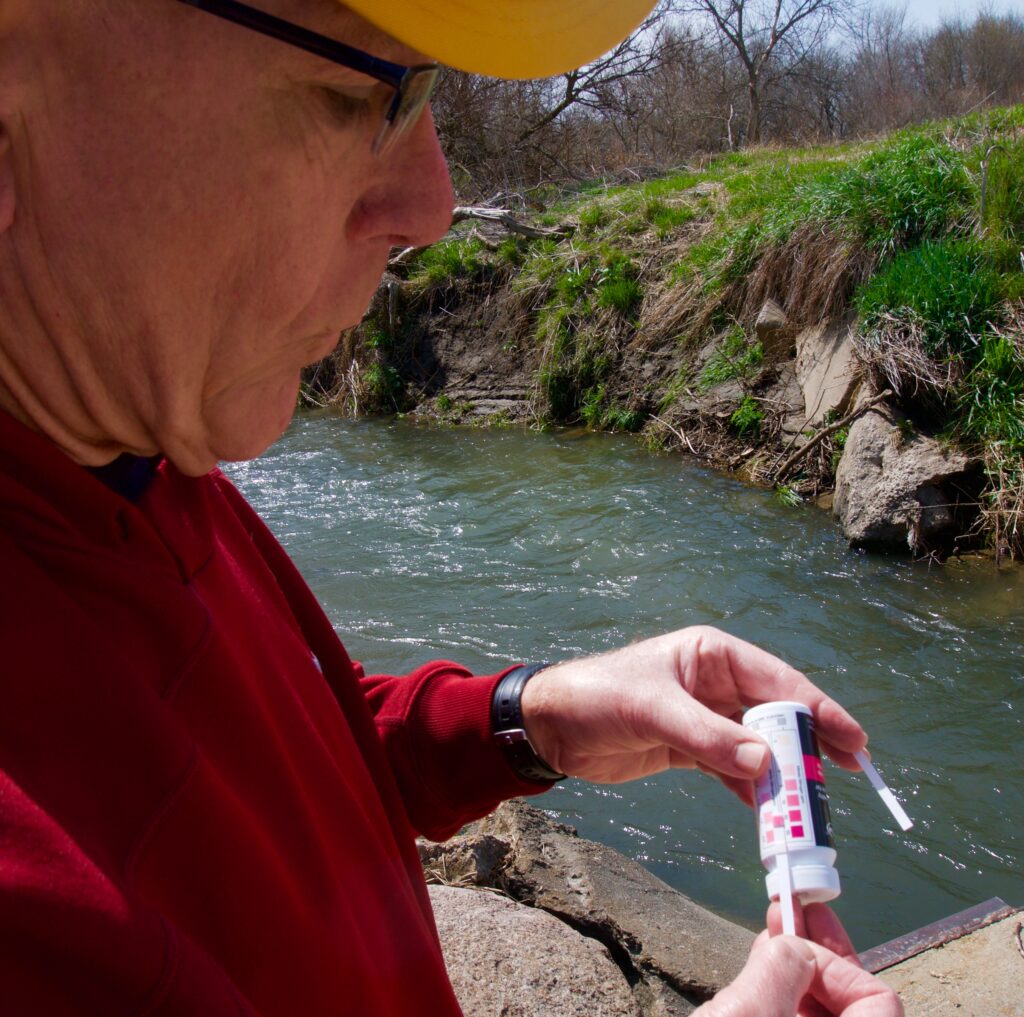
In Venice, Kindra Arnesen says the dead zone is the most evident consequence of the Mississippi River’s nitrogen load. Another is on the way. Louisiana is mounting big coastal restoration projects to rebuild shoreline damaged by oil industry canals, oil spills, and salt water intrusion. The state is diverting the river’s fresh water and sediments into estuaries to restore marshes and establish new land.
But nitrogen in the water and sediments is a huge threat, Arnesen says. It will cause vegetation to develop shallow roots and become vulnerable to being ripped away by storms, destroying the habitat where young shrimp and fish develop.
“They’ve got everybody believing that this river carries enough sediment that in 50 years it’s going to a build a massive amount of land,” she said. “But scientists tell me that in the first 60 days of operation there’s going to be a negative impact to 260,000 acres of vegetation. The roots will actually retract. They’ll no longer have to reach so deep for nutrients because there’ll be so much in the polluted river water. When we have another storm, they’ll rip up like carpet. They’re gone.”
Back to Iowa, Clark Porter is trying to increase the number of farmers who embrace more environmentally sensitive approaches to their operations. “How can we understand the best way to educate and influence conservation decisions?” he asks. “I tell them it’s different than it was when we did conventional tillage and no cover crops. But it produces better soil biology. It’s healthier, more balanced, more active and alive now than it was before I started. I’m getting yields that I’m happy with. I’m not spending as much money on the front end. I feel better about the effects on my neighbors and people downstream.”
— Keith Schneider
A version of this article was first published by The New Lede. See all of our Toxic Terrain reporting on the national scandal of farm nutrient pollution.
